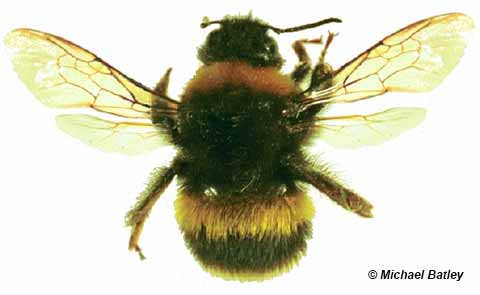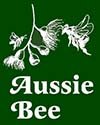HOW TO IDENTIFY A FERAL BUMBLEBEE
Aussie Bee > Bumblebee Problem > Identify a Bumblebee
Other Aussie Bee reports on Bumble Bees:
-- Have you seen a bumblebee on the Australian mainland?
-- What harm could exotic bumblebees cause?
-- How far could feral bumblebees spread in Australia
-- Bumblebees and invasive weeds in Australia
-- The native bee alternative to the exotic bumblebee
We have no native bumblebees in Australia, but there are feral European Bumblebees in Tasmania. Please help us keep exotic Bumblebees out of mainland Australia! Be on the lookout for Bumblebees (described below) on the Australian mainland and report any sightings to local authorities!

The European Bumblebee or Large Earth Bumblebee, Bombus terrestris, now feral in Tasmania. (Photo derived from work by Vera Buhl, CC BY-SA 3.0.)
The Bumblebee which is most likely to slip through quarantine on the Australian mainland is the European Bumblebee, Bombus terrestris, because of the feral population of this species in Tasmania.
Please note though, that several Australian native bee species are sometimes mistaken for the European Bumblebee. The following information will help you work out if a bee that you have seen is a feral Bumblebee or an Australian native bee.
European Bumblebee
or Large Earth Bumblebee
Bombus terrestris

The European Bumble Bees, Bombus terrestris, feral in Tasmania, are large, fat and very hairy. Worker bees may be 8 mm to 22 mm in length while queen bees are up to about 25 mm. They are black with one yellow/ochre band across the thorax and another across the abdomen. The tip of the abdomen is also buff or white. More photos of Bumblebees. (Photo by Dr Michael Batley)
Native Great Carpenter Bee
Xylocopa aruana

The Australian native Great Carpenter Bee females are 13–18 mm long with a bright yellow thorax and a black abdomen. Unlike the bumble bee, the abdomen of the female carpenter bee is shiny and hairless. Male Great Carpenter Bees are about the same size but are completely covered with yellow brown or dull olive hair. More photos of Great Carpenter Bees. (Photo by Aussie Bee)
Native Teddy Bear Bee
Amegilla bombiformis

The Australian native Teddy Bear Bees are 13–18 mm long and completely covered with ochre fur except for one narrow black stripe on the abdomen. More photos of Teddy Bear Bees. (Photo by Dr Michael Batley)
Native Blue Banded Bee
Amegilla sp.

The Australian native Blue Banded Bees are 10–14 mm long with reddish brown fur on the thorax and pale blue stripes across the black abdomen. More photos of Blue Banded Bees. (Photo by Dr Michael Batley)
Bumblebee Nests
Bumblebee nests are usually about 10 cm under the soil surface. Nests have been found in:
-- old rodent nests (inside sheds or outdoors)
-- compost heaps
-- piles of leaf litter or grass clippings
-- woodpiles
-- old stuffed chairs or sofas
-- covered drains
-- cavities underneath concrete paths or houses.

Above: a nest of the European Bumblebee, Bombus terrestris, with honey pots, pollen pots and brood cells, nestled inside a grassy cradle. (Drawing by Tarlton Rayment, A Cluster of Bees, 1935.)
A thriving colony may have a queen and 200 to 300 workers. The nests are usually in a small cavity containing fine grass fibres for insulation of the brood.
Other Aussie Bee reports on Bumble Bees:
-- Have you seen a bumblebee on the Australian mainland?
-- What harm could exotic bumblebees cause?
-- How far could feral bumblebees spread in Australia
-- Bumblebees and invasive weeds in Australia
-- The native bee alternative to the exotic bumblebee



